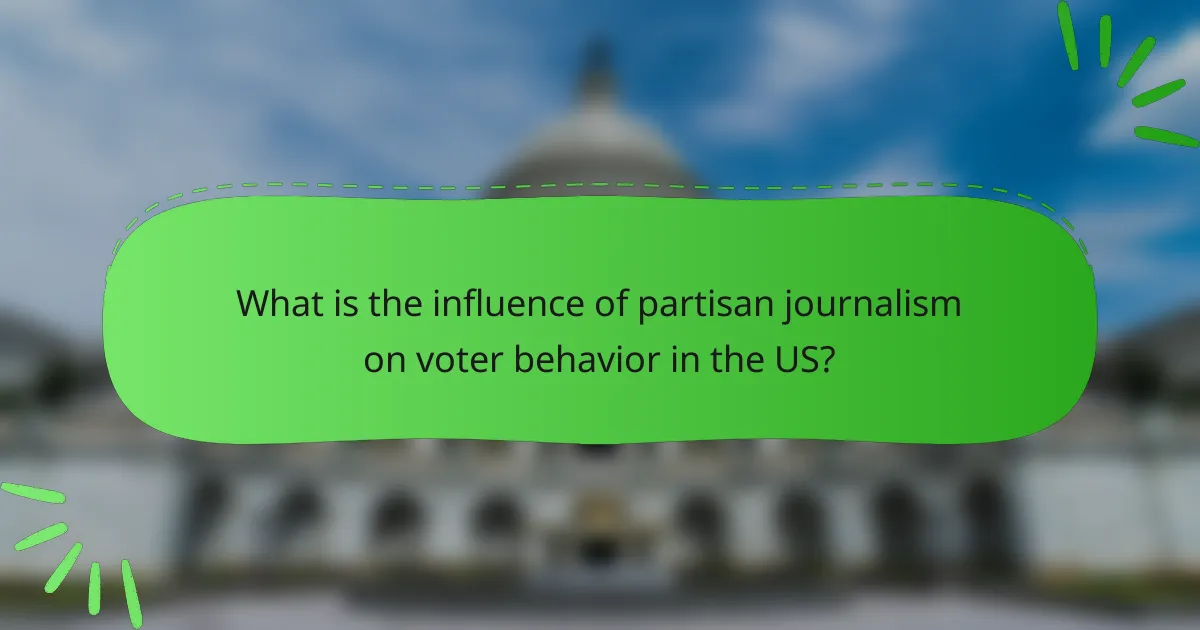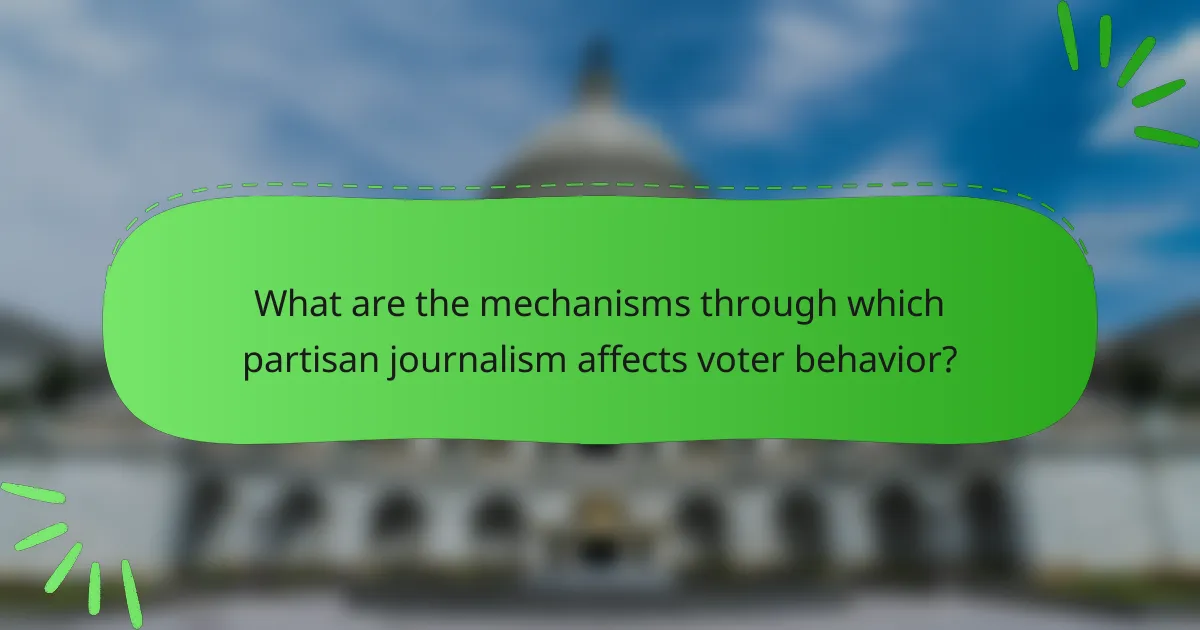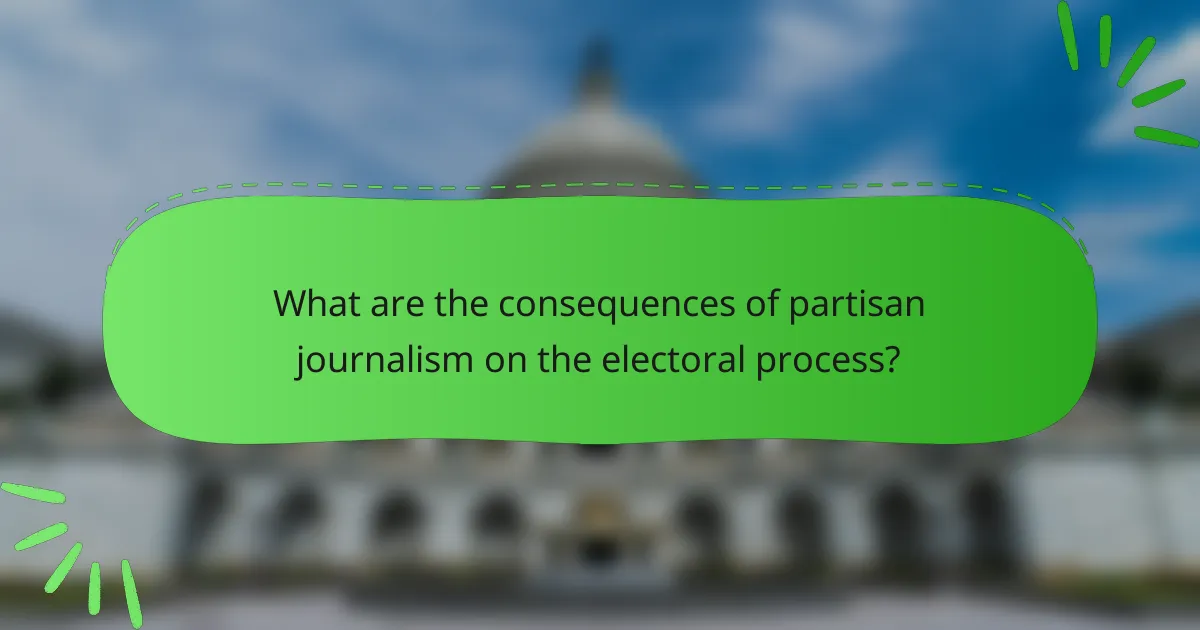Partisan journalism is a significant factor influencing voter behavior in the United States. It shapes public perception by framing issues in alignment with specific political ideologies, leading to stronger partisan identities among individuals exposed to such media. Research indicates that 62% of Americans perceive news organizations as biased, which contributes to increased polarization and can skew electoral outcomes. The article explores how partisan journalism fosters confirmation bias and agenda-setting, reinforcing existing beliefs and impacting voter decisions. It highlights the consequences of selective media consumption, including diminished critical thinking and decreased trust in the electoral process.

What is the influence of partisan journalism on voter behavior in the US?
Partisan journalism significantly influences voter behavior in the US. It shapes public perception by framing issues in a way that aligns with specific political ideologies. Research indicates that individuals exposed to partisan media tend to develop stronger partisan identities. A study by the Pew Research Center found that 62% of Americans believe news organizations favor one side of the political spectrum. This bias can lead to increased polarization among voters. Furthermore, partisan journalism affects voting decisions by reinforcing existing beliefs and discouraging critical analysis of opposing viewpoints. As a result, voters may become more entrenched in their political positions, impacting electoral outcomes.
How does partisan journalism shape public perception?
Partisan journalism shapes public perception by presenting news through a biased lens. This bias influences how audiences interpret events and issues. Research indicates that exposure to partisan media can reinforce existing beliefs. For instance, a study by the Pew Research Center found that individuals consuming partisan news are more likely to hold polarized views. This polarization affects political attitudes and voting behavior. Furthermore, partisan journalism often highlights specific narratives, which can skew public understanding. By prioritizing certain facts over others, it creates a selective reality for its audience. Overall, partisan journalism plays a significant role in shaping how people perceive political information.
What are the key characteristics of partisan journalism?
Partisan journalism is characterized by a clear bias towards a specific political ideology or party. This type of journalism often presents news stories in a way that aligns with the interests and values of that ideology. It selectively highlights facts that support its viewpoint while downplaying or ignoring opposing perspectives.
Partisan journalism frequently employs emotionally charged language to influence audience sentiment. It often features opinion pieces disguised as news, blurring the lines between reporting and advocacy. Additionally, it may rely on echo chambers, where like-minded individuals reinforce each other’s beliefs. This approach can lead to polarization among audiences, as individuals consume information that confirms their pre-existing views.
Research indicates that partisan journalism can significantly affect voter behavior. A study by the Pew Research Center found that individuals who engage with partisan media are more likely to hold extreme views and participate in political activities. This underscores the role of partisan journalism in shaping public opinion and electoral outcomes.
How do these characteristics impact voter opinions?
Partisan journalism characteristics significantly impact voter opinions by shaping perceptions and beliefs. These characteristics include bias, framing, and selective reporting. Bias in reporting can lead voters to align with specific political ideologies. For instance, studies show that exposure to biased news sources can reinforce existing beliefs among viewers. Framing affects how issues are presented, influencing voter interpretation. Research indicates that the framing of political issues can alter public opinion by highlighting certain aspects while downplaying others. Selective reporting can create a skewed understanding of events, leading to misinformed voter decisions. Data suggests that voters who consume partisan news are more likely to exhibit polarized opinions. Thus, the characteristics of partisan journalism play a crucial role in shaping voter attitudes and decisions.
Why is understanding this influence important for democracy?
Understanding the influence of partisan journalism on voter behavior is crucial for democracy. Partisan journalism shapes public opinion and can lead to polarization among voters. When citizens consume biased information, it affects their decision-making processes. This can result in an electorate that is misinformed or overly influenced by specific narratives. Research indicates that exposure to partisan news can reinforce existing beliefs and diminish critical thinking. A study by the Pew Research Center found that individuals who primarily consume partisan news are less likely to engage with opposing viewpoints. This trend can undermine democratic discourse and hinder collaborative problem-solving. Therefore, recognizing this influence is essential to fostering an informed and engaged electorate.
What role does media play in shaping electoral outcomes?
Media plays a crucial role in shaping electoral outcomes by influencing public perception and voter behavior. It serves as the primary source of information for voters during elections. Media coverage can highlight specific issues, candidates, and policies, thereby directing public attention. Partisan journalism can sway opinions by framing narratives that align with particular political ideologies. Studies show that voters often trust media outlets that share their political views, reinforcing existing biases. This can lead to echo chambers, where individuals only consume information that confirms their beliefs. Additionally, media can impact voter turnout by mobilizing supporters through targeted messaging. Historical data indicates that increased media engagement correlates with higher voter participation rates. Thus, the media’s portrayal of candidates and issues significantly influences electoral outcomes.
How can partisan journalism affect voter turnout?
Partisan journalism can significantly affect voter turnout by shaping public perception and engagement. When media outlets present biased information, they can influence how individuals perceive political candidates and issues. This can lead to increased enthusiasm among supporters of a particular party. According to a study by the Pew Research Center, 62% of Americans believe that news organizations favor one side in their reporting. This perceived bias can mobilize voters who feel strongly about their party’s stance. Conversely, it may also discourage voters who feel alienated by the coverage. Research indicates that negative portrayals of candidates can lead to voter apathy, reducing overall turnout. Thus, partisan journalism plays a crucial role in either energizing or dissuading the electorate.

What are the mechanisms through which partisan journalism affects voter behavior?
Partisan journalism affects voter behavior primarily through confirmation bias and agenda-setting. Confirmation bias leads voters to seek information that aligns with their pre-existing beliefs. This results in increased support for candidates or policies that resonate with their views. Agenda-setting occurs when partisan outlets highlight specific issues, shaping the public discourse. Research shows that exposure to partisan news can influence voter perceptions and priorities. For instance, a study by Levendusky (2013) demonstrated that viewers of partisan media were more likely to adopt the political opinions presented. This illustrates how partisan journalism can significantly sway voter attitudes and decisions.
How do biases in reporting influence voter decisions?
Biases in reporting significantly influence voter decisions by shaping perceptions of candidates and issues. Partisan journalism often presents information in a way that favors one political perspective over another. This can lead voters to develop skewed understandings of policies and candidate qualifications. Research indicates that exposure to biased news can reinforce existing beliefs, making voters less likely to consider opposing viewpoints. For instance, a study by the Pew Research Center found that individuals who consume partisan news are more likely to hold polarized views. This reinforces the idea that biases in reporting can drive voter behavior in a polarized political environment.
What are common biases found in partisan journalism?
Common biases found in partisan journalism include confirmation bias, selection bias, and framing bias. Confirmation bias occurs when journalists favor information that supports their political views. Selection bias happens when news outlets choose stories that align with their partisan stance while ignoring opposing viewpoints. Framing bias involves presenting information in a way that influences audience perception, often highlighting certain aspects while downplaying others. These biases can shape public opinion and voter behavior significantly. Research indicates that partisan media consumption correlates with increased polarization among audiences, affecting their political beliefs and actions.
How do these biases manifest in election coverage?
Biases manifest in election coverage through selective reporting and framing. Journalists may highlight specific events or statements that favor one candidate over another. This can lead to an imbalanced portrayal of candidates. For example, negative stories about one candidate may receive more airtime than similar stories about another. Additionally, language used in headlines can shape public perception. Emotional or loaded terms may sway voter opinions. Studies show that partisan outlets often prioritize stories that align with their political stance. This practice can influence voter behavior by reinforcing existing beliefs. Research indicates that exposure to biased coverage correlates with increased polarization among voters.
What psychological factors contribute to the influence of partisan journalism?
Cognitive biases significantly contribute to the influence of partisan journalism. Confirmation bias leads individuals to favor information that aligns with their preexisting beliefs. This bias reinforces existing opinions and diminishes the impact of opposing viewpoints. Emotional appeal is another psychological factor at play. Partisan journalism often evokes strong emotions, which can enhance engagement and retention of information.
Social identity theory also plays a role. Individuals identify with particular political groups and perceive information through that lens. This identification can create an in-group bias, where individuals trust information from their group more than from outside sources. Additionally, motivated reasoning affects how people process information. Individuals may interpret facts in a way that supports their political stance, rather than objectively assessing the information.
Research indicates that these psychological factors can lead to polarized opinions among voters. A study by the Pew Research Center found that exposure to partisan media increases political polarization. This polarization can affect voting behavior by solidifying party loyalty and influencing electoral decisions.
How does confirmation bias affect voter engagement with news?
Confirmation bias significantly influences voter engagement with news. It leads individuals to favor information that aligns with their pre-existing beliefs. Voters often seek out news sources that reflect their political preferences. This selective exposure reinforces their views and discourages consideration of opposing perspectives. Research shows that confirmation bias can result in polarized opinions and reduced trust in media outlets that present differing viewpoints. For instance, a study by the Pew Research Center found that individuals who consume partisan news are more likely to exhibit strong confirmation bias. This behavior ultimately shapes voter attitudes and engagement levels in the political landscape.
What role does emotional appeal play in partisan reporting?
Emotional appeal plays a significant role in partisan reporting by influencing audience perceptions and reactions. Partisan media outlets often use emotionally charged language to evoke strong feelings, such as anger or fear. This tactic can deepen political polarization among viewers. Research shows that emotionally appealing content is more likely to be shared on social media, amplifying its reach. A study by the Pew Research Center found that emotionally resonant stories can increase engagement and reinforce existing beliefs. Thus, emotional appeal is a strategic tool in partisan reporting that shapes voter behavior and public opinion.

What are the consequences of partisan journalism on the electoral process?
Partisan journalism significantly skews the electoral process. It creates polarized narratives that misinform voters. This leads to increased division among the electorate. Voters may only consume media that aligns with their beliefs. Such selective exposure reinforces existing biases. Research shows that this can diminish critical thinking about candidates and issues. A study by the Pew Research Center found that 62% of Americans believe news organizations favor one side. This perception can decrease trust in media and increase cynicism about the electoral process. Ultimately, partisan journalism can undermine democratic engagement and informed voting.
How does partisan journalism impact voter polarization?
Partisan journalism increases voter polarization by reinforcing existing biases and creating echo chambers. This type of journalism often presents information that aligns with specific political ideologies. As a result, audiences consume news that confirms their pre-existing beliefs. Studies show that individuals exposed to partisan media are more likely to adopt extreme political views. Research from the Pew Research Center indicates that partisan news consumption correlates with heightened political animosity. Furthermore, this polarization can lead to decreased willingness to engage with opposing viewpoints. The overall effect is a more divided electorate, making bipartisan cooperation increasingly difficult.
What evidence exists to support increased polarization linked to media consumption?
Increased polarization linked to media consumption is evidenced by several studies. Research shows that individuals consuming partisan media are more likely to adopt polarized views. A study by the Pew Research Center found that 36% of Americans reported consuming news from sources that align with their political beliefs. This selective exposure leads to echo chambers, reinforcing existing beliefs. Another study published in the Journal of Communication found that partisan media consumption significantly correlates with increased political polarization. It indicated that individuals who primarily consume conservative or liberal media exhibit more extreme political attitudes. These findings highlight the direct relationship between media consumption patterns and political polarization in the United States.
How does polarization affect political discourse and collaboration?
Polarization negatively affects political discourse and collaboration. It creates an environment where opposing viewpoints are dismissed. This leads to increased hostility and reduced willingness to engage in constructive dialogue. Research shows that polarized individuals are less likely to compromise. A study by Pew Research Center found that 70% of Americans feel that political divisions hinder problem-solving. Furthermore, polarization can result in echo chambers, where individuals only interact with like-minded people. This limits exposure to diverse perspectives. Consequently, collaboration across party lines becomes increasingly difficult.
What strategies can voters use to mitigate the effects of partisan journalism?
Voters can mitigate the effects of partisan journalism by diversifying their news sources. Consuming a range of media outlets helps to balance perspectives. Engaging with non-partisan fact-checking organizations can clarify misinformation. Participating in discussions with individuals holding differing views fosters critical thinking. Utilizing social media responsibly reduces echo chamber effects. Educating oneself about media literacy enhances the ability to discern bias. Research shows that diverse media consumption leads to more informed voting decisions. Studies indicate that critical engagement with news can reduce susceptibility to partisan narratives.
How can voters identify and consume unbiased news sources?
Voters can identify and consume unbiased news sources by evaluating the credibility and objectivity of the outlets. They should look for news organizations that adhere to journalistic standards and provide fact-based reporting. Checking for transparency in sourcing and citing information is crucial. Voters can also assess whether a news outlet presents multiple viewpoints on issues. Additionally, reviewing the outlet’s history of accuracy and accountability helps gauge its reliability. Studies show that media literacy education enhances the ability to discern bias in news. For instance, the Pew Research Center found that individuals with higher media literacy skills are better at identifying credible news sources.
What practices can enhance critical thinking about media consumption?
Practices that can enhance critical thinking about media consumption include evaluating sources, cross-referencing information, and questioning biases. Evaluating sources involves checking the credibility and expertise of the author or organization. Cross-referencing information means comparing facts across multiple reputable outlets. Questioning biases requires recognizing the potential influences of political, social, or economic agendas on the content. Research indicates that individuals who engage in these practices are better equipped to discern misinformation. A study by the Pew Research Center found that media literacy education significantly improves critical thinking skills regarding news consumption.
The main entity of this article is partisan journalism and its influence on voter behavior in the US. The article examines how partisan journalism shapes public perception, reinforces biases, and contributes to voter polarization, leading to significant impacts on electoral outcomes. Key characteristics of partisan journalism, such as biased reporting and emotional appeal, are discussed, alongside their effects on voter opinions and turnout. Additionally, the article highlights the psychological factors driving these influences and suggests strategies for voters to mitigate the effects of partisan media consumption.